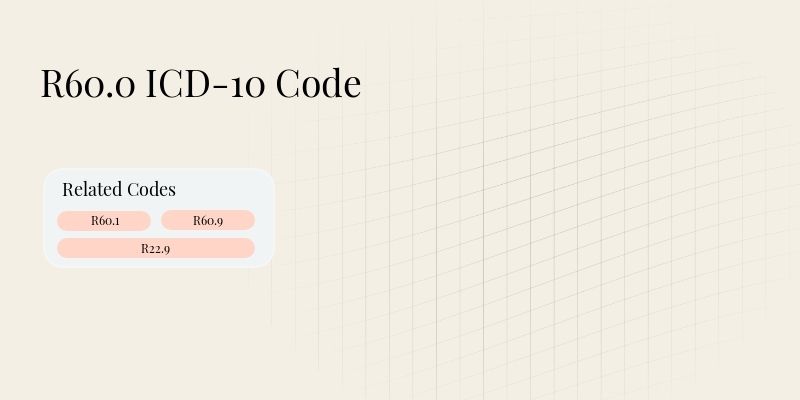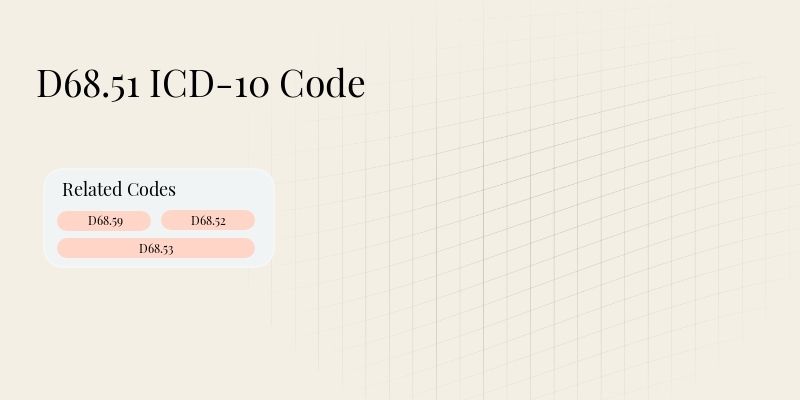
R60.0 ICD-10 Code: Peripheral Edema

Key Takeaways
- What R60.0 ICD-10 Code Covers: This code indicates the presence of peripheral edema, a condition characterized by swelling due to excess fluid in the tissues, often seen in the legs and feet.
- Session duration requirements: Typically, a patient may need to have ongoing assessments over multiple visits to accurately document and support the use of this code, particularly if the edema is recurrent or chronic.
- Who can use the code: Various healthcare professionals, including primary care physicians, specialists, and urgent care providers, can apply this code when diagnosing patients with peripheral edema.
- Best practice for proper use: Ensure comprehensive documentation, including patient history, physical examination findings, and any underlying conditions that may contribute to edema.
- Example of actual usage: A patient visits a primary care physician due to swollen ankles. After an assessment, the physician documents the condition as peripheral edema and assigns the R60.0 code for billing purposes.
What is R60.0 ICD-10 Code
The R60.0 ICD‑10 code is specifically designated for peripheral edema, which refers to swelling that occurs when excess fluid builds up in the tissues of the body, primarily affecting the limbs. This condition can arise from various underlying issues, including heart failure, kidney problems, or venous insufficiency.
Understanding this code is crucial for healthcare providers as it not only assists in the diagnosis but also plays a vital role in treatment planning and patient management. Proper coding facilitates the reimbursement process and supports the documentation of patient care, ensuring that the reasons for visits are accurately reflected in billing practices.
Services Covered Under R60.0 ICD-10 Code
Several services are typically associated with the diagnosis of peripheral edema. Below is a detailed table showing the services related to the R60.0 code.
Service | Description |
|---|---|
Physical Examination | A thorough evaluation of the patient, including checking for signs of swelling and assessing overall health. |
Diagnostic Imaging | Ultrasounds or other imaging techniques may be used to assess fluid accumulation and check for underlying causes. |
Laboratory Tests | Blood tests to evaluate kidney function, heart function, and other relevant conditions that could contribute to edema. |
Follow-up Visits | Regular check-ups to monitor the condition's progression and adjust treatment as necessary. |
Who Can Use the R60.0 ICD-10 Code?
Various healthcare providers can apply the R60.0 code in their practice. Here are the professionals who may use this code:
- Primary Care Physicians: Frequently encounter patients with swelling and can diagnose peripheral edema.
- Cardiologists: Often treat patients with heart conditions that may lead to edema and require accurate documentation.
- Nephrologists: Specialize in kidney-related issues that can contribute to fluid retention and swelling.
- Urgent Care Providers: Can address acute instances of peripheral edema, ensuring proper coding for immediate care.
How to Use R60.0 ICD-10 Code
Using this code correctly is essential for accurate billing and patient care documentation. Here are steps to consider:
- Document Symptoms: Record detailed patient symptoms such as duration and severity of swelling. For instance, a patient reporting swelling in the legs for the past two weeks should have these details noted.
- Assess Underlying Conditions: Evaluate any potential underlying health issues, such as heart failure or kidney disease. For example, if the patient has a history of congestive heart failure, this should be documented.
- Follow-up Documentation: Ensure that follow-up visits include updated assessments of the edema. If the swelling persists, note any changes in treatment plans during subsequent visits.
Reimbursement Rates for R60.0 ICD-10 Code
Insurance Type | Reimbursement Rate |
|---|---|
Medicare | $85.00 |
Medicaid | $75.00 |
Private Insurance (Average) | $95.00 |
Disclaimer: Reimbursement rates can change frequently based on various factors, including policy updates and regional considerations. This article will be updated regularly to reflect current averages.
Benefits of R60.0 ICD-10 Code
Correctly applying this code can lead to several significant benefits. Below is a table outlining these advantages.
Benefit | Description |
|---|---|
Improved Patient Management | Accurate coding aids in monitoring treatment efficacy and adjusting care plans accordingly. |
Streamlined Billing Process | Using the correct code ensures timely reimbursement and reduces claim denials. |
Enhanced Data Collection | Facilitates the gathering of data for public health tracking and research on peripheral edema. |
Better Communication | Clear documentation supports communication among healthcare providers regarding patient status and treatment strategies. |
Common Mistakes to Avoid with R60.0 ICD-10 Code
Misuse of the R60.0 code can lead to significant risks, including audits and claim denials. Below are common mistakes to be aware of:
- Incorrect Diagnosis Coding: Failing to differentiate between acute and chronic edema can lead to billing errors. For example, coding chronic conditions as acute may result in insurance claim denials.
- Lack of Documentation: Not providing sufficient documentation to support the use of the code can trigger audits. An example includes failing to note the patient’s medical history relevant to edema.
- Ignoring Follow-Up Visits: Not coding follow-up visits that address persistent symptoms can lead to lost revenue. For instance, if a patient’s edema is monitored over several visits, each should be accurately documented and coded.
- Mixing Up Codes: Confusing R60.0 with other edema codes can complicate billing. An example is using the code for localized edema when the condition is generalized.
R60.0 ICD-10 Code vs Other Codes
It is essential to differentiate the R60.0 code from similar codes to ensure accurate coding. Below is a comparison table of relevant codes:
Code | Description | Differences |
|---|---|---|
R60.0 | Peripheral Edema | Refers specifically to generalized swelling due to fluid accumulation. |
R60.1 | Localized Edema | Applies to swelling confined to a specific body area, such as a limb. |
I87.2 | Venous Insufficiency | Describes underlying conditions that can lead to peripheral edema but is not a direct diagnosis of edema itself. |
Conclusion
The R60.0 ICD‑10 code is critical for accurately diagnosing and managing peripheral edema. Understanding what this code covers, the services associated with it, and who can apply it is essential for healthcare providers. Proper documentation and coding practices are vital for ensuring reimbursement and maintaining compliance with billing regulations. By recognizing common mistakes and differentiating this code from similar ones, healthcare professionals can enhance patient care and streamline the billing process. Overall, effective use of this code contributes significantly to the quality of care provided to patients experiencing peripheral edema.
Disclaimer: This article is for informational purposes only and does not constitute legal or medical advice. Always consult professional guidelines and regulatory bodies for specific compliance requirements.
Frequently Asked Questions
Reduce burnout,
improve patient care.
Join thousands of clinicians already using AI to become more efficient.

CO-11 Denial Code: Diagnosis/Procedure Mismatch
Discover essential insights on the CO-11 Denial Code code for health professionals. Enhance your practice and navigate billing with confidence.

CO-45 Denial Code: Charge Exceeds Contracted Amount
Discover essential insights on the CO-45 Denial Code code for health professionals. Enhance your practice and navigate billing with confidence.

D68.51 ICD-10 Code: Factor v Leiden
Discover essential insights on the D68.51 ICD-10 Code code for health professionals. Enhance your practice and navigate billing with confidence.
